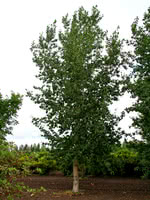Mon-Fri 9am - 5pm Mountain time
Common Hackberry vs Okanese Poplar
Celtis occidentalis
Populus x Okanese
The Common Hackberry is a medium-sized deciduous tree that resembles the American Elm but is immune to Dutch Elm Disease. They are versatile and can adapt to a variety of growing conditions.
It produces purple-red, berry-like fruit with a large seed in the center. Both the sweet flesh, which tastes similar to dates, and the crunchy seed are edible. The fruit remains on the tree throughout the winter, offering a valuable food source for birds and other wildlife.
The Common Hackberry can also be a great addition to a pollinator garden. The tree itself is a host for the larvae of several butterfly species and the flowers provide a source of pollen and nectar.
Okanese Poplar is an excellent shelterbelt tree. It's one of the hardiest and fastest growing trees you can plant on the prairies. This hybrid poplar is disease resistant, drought and cold tolerant, produces no fuzz, and requires little maintenance. Okanese poplar also makes for a good privacy screen on larger properties.
Common Hackberry Quick Facts
Okanese Poplar Quick Facts
In row spacing: 2.4 - 3 m (8 - 10 ft)

